This article is more than one year old. Older articles may contain outdated content. Check that the information in the page has not become incorrect since its publication.
How to Proxy Dubbo Services through Apache ShenYu Gateway
Dubbo services through the Apache ShenYu gateway, covering the main content from simple examples to core calling process analysis, and summarizing design principles.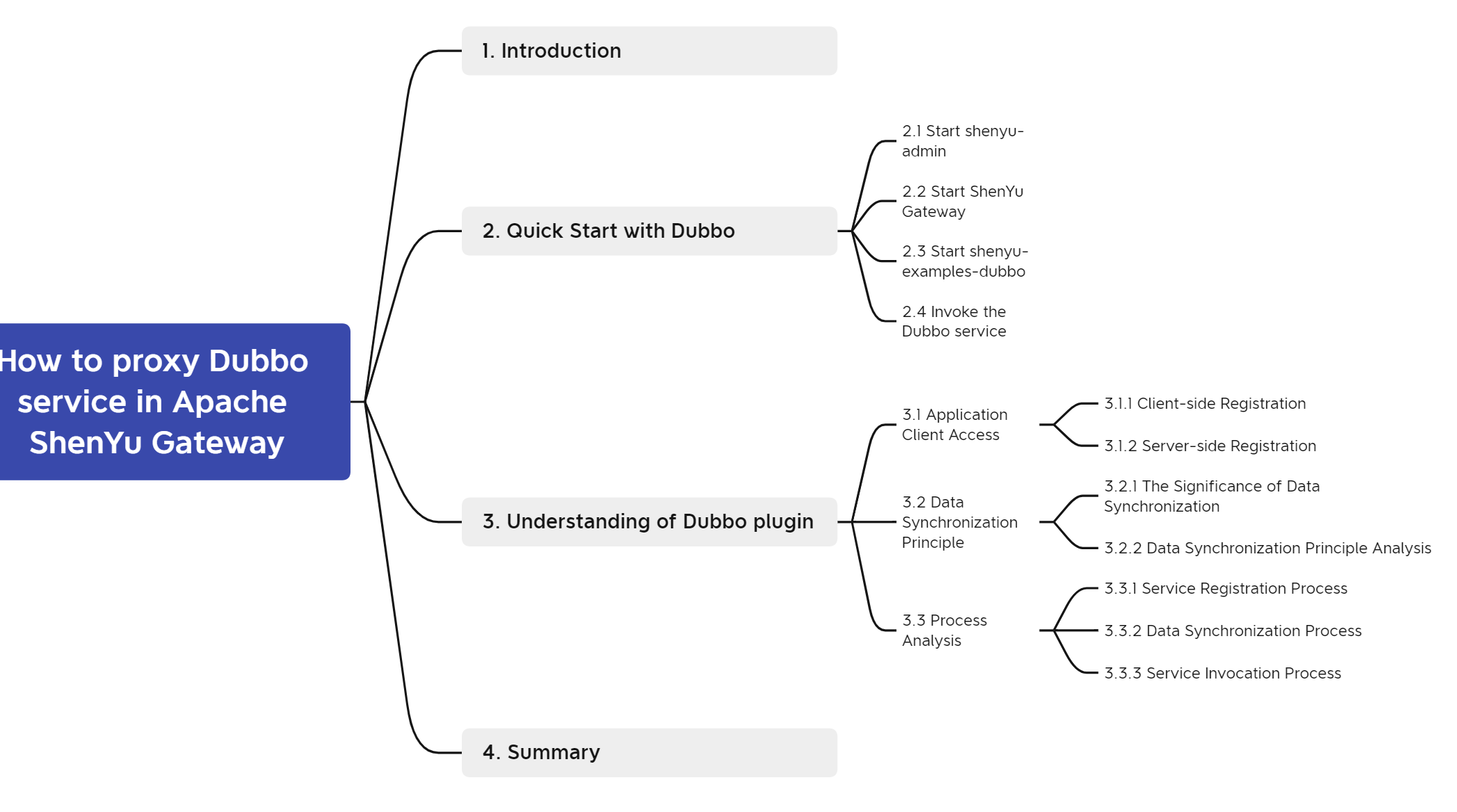
1. Introduction
- Apache ShenYu
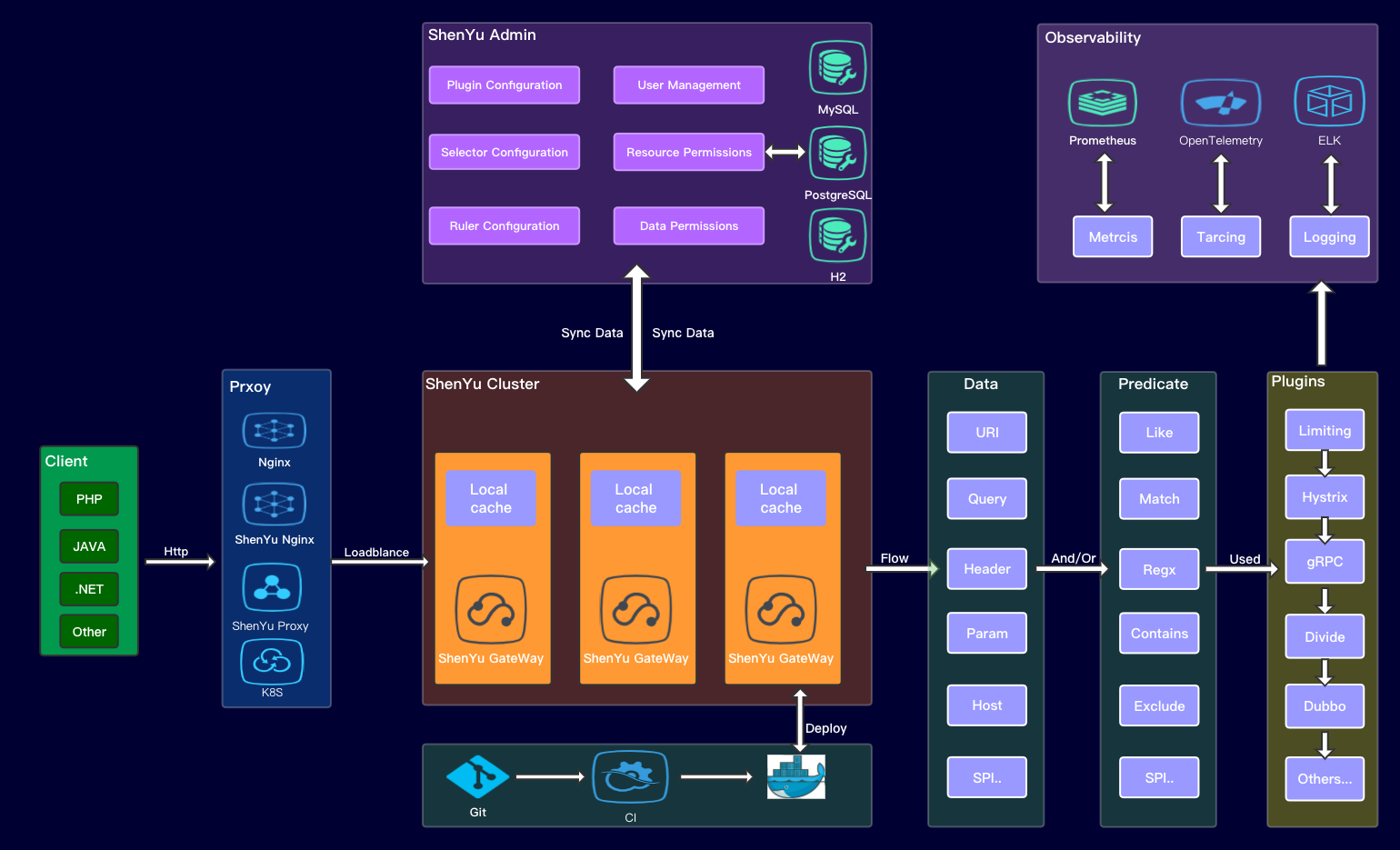
Apache ShenYu(Incubating) is an asynchronous, high-performance, cross-language, and responsive API gateway. Compatible with various mainstream framework systems, it supports hot swapping, and users can customize development to meet various current and future needs through large-scale scenario testing.
In May 2021, ShenYu was donated to the Apache Software Foundation, which was fully approved by the Apache Foundation and successfully entered the incubator.
- Apache Dubbo
Apache Dubbo is a microservices development framework that provides two key capabilities: RPC communication and microservice governance. This means that microservices developed using Dubbo will have remote discovery and communication capabilities among themselves, while utilizing the rich service governance capabilities provided by Dubbo to implement service governance requirements such as service discovery, load balancing, and traffic scheduling. Additionally, Dubbo is highly extensible, allowing users to customize their implementations at almost any function point to change the default behavior of the framework to meet their business needs.
2. Quick Start with Dubbo
This section introduces how to integrate Dubbo services into the ShenYu gateway. You can find the example code for this section directly under the project.
2.1 Start shenyu-admin
shenyu-admin is the backend management system for Apache ShenYu. There are various ways to start it; this article will start it via [local deployment](https://shenyu.apache.org/docs/deployment/deployment-local). Once successfully started, you need to enable the dubbo plugin in the basic configuration -> plugin management, and set your registration address. Please ensure that the registration center is already running.
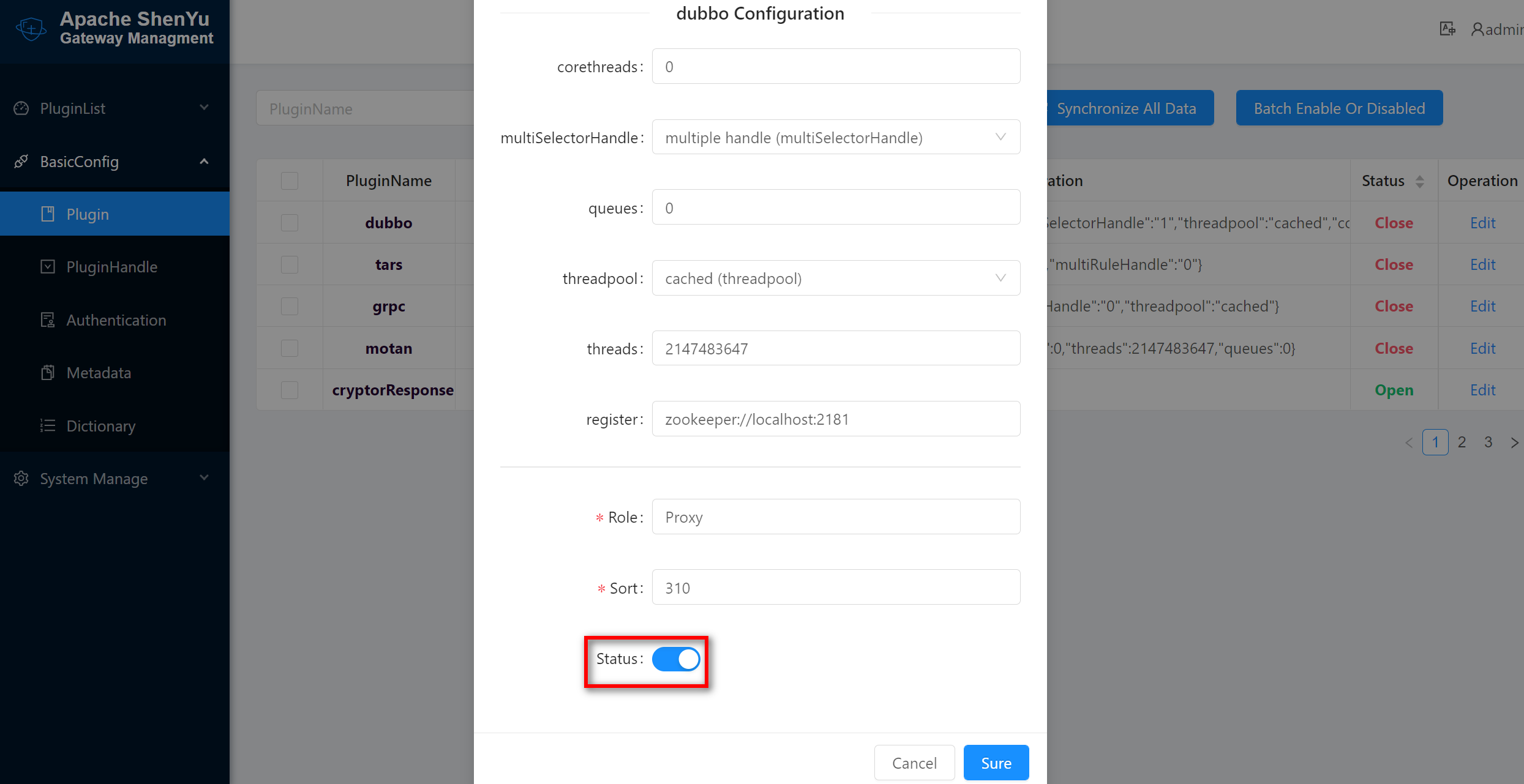
2.2 Start shenyu gateway
Here we start it through the source code, running ShenyuBootstrapApplication in shenyu-bootstrap directly.
Before starting, please ensure that the gateway has relevant dependencies introduced. If the client is apache dubbo, and the registration center uses zookeeper, please refer to the following configuration:
<!-- apache shenyu apache dubbo plugin start-->
<dependency>
<groupId>org.apache.shenyu</groupId>
<artifactId>shenyu-spring-boot-starter-plugin-apache-dubbo</artifactId>
<version>${project.version}</version>
</dependency>
<dependency>
<groupId>org.apache.dubbo</groupId>
<artifactId>dubbo</artifactId>
<version>2.7.5</version>
</dependency>
<!-- Dubbo zookeeper registry dependency start -->
<dependency>
<groupId>org.apache.curator</groupId>
<artifactId>curator-client</artifactId>
<version>4.0.1</version>
<exclusions>
<exclusion>
<artifactId>log4j</artifactId>
<groupId>log4j</groupId>
</exclusion>
</exclusions>
</dependency>
<dependency>
<groupId>org.apache.curator</groupId>
<artifactId>curator-framework</artifactId>
<version>4.0.1</version>
</dependency>
<dependency>
<groupId>org.apache.curator</groupId>
<artifactId>curator-recipes</artifactId>
<version>4.0.1</version>
</dependency>
<!-- Dubbo zookeeper registry dependency end -->
<!-- apache dubbo plugin end-->
2.3 Start shenyu-examples-dubbo
Taking the example provided by the official website shenyu-examples-dubbo as an example. Suppose the dubbo service is defined as follows:
<beans /* ...... * />
<dubbo:application name="test-dubbo-service"/>
<dubbo:registry address="${dubbo.registry.address}"/>
<dubbo:protocol name="dubbo" port="20888"/>
<dubbo:service timeout="10000" interface="org.apache.shenyu.examples.dubbo.api.service.DubboTestService" ref="dubboTestService"/>
</beans>
Declare the application service name, registration center address, use the dubbo protocol, and declare the service interface corresponding to the implementation class:
/**
* DubboTestServiceImpl.
*/
@Service("dubboTestService")
public class DubboTestServiceImpl implements DubboTestService {
@Override
@ShenyuDubboClient(path = "/findById", desc = "Query by Id")
public DubboTest findById(final String id) {
return new DubboTest(id, "hello world shenyu Apache, findById");
}
//......
}
In the interface implementation class, use the annotation @ShenyuDubboClient to register the service in shenyu-admin.
In the configuration file application.yml:
server:
port: 8011
address: 0.0.0.0
servlet:
context-path: /
spring:
main:
allow-bean-definition-overriding: true
dubbo:
registry:
address: zookeeper://localhost:2181 # dubbo registration center
shenyu:
register:
registerType: http # Registration method
serverLists: http://localhost:9095 # Registration address
props:
username: admin
password: 123456
client:
dubbo:
props:
contextPath: /dubbo
appName: dubbo
In the configuration file, declare the registration center address used by dubbo, register the dubbo service with shenyu-admin, using the method http, and the registration address is http://localhost:9095.
For information on registration methods, please refer to [Application Client Access](https://shenyu.apache.org/docs/design/register-center-design/).
2.4 Call dubbo service
Once the shenyu-examples-dubbo project starts successfully, the interfaces with the @ShenyuDubboClient annotation will automatically register with the gateway.
Open Plugin List -> Proxy -> dubbo to view the plugin rule configuration list:
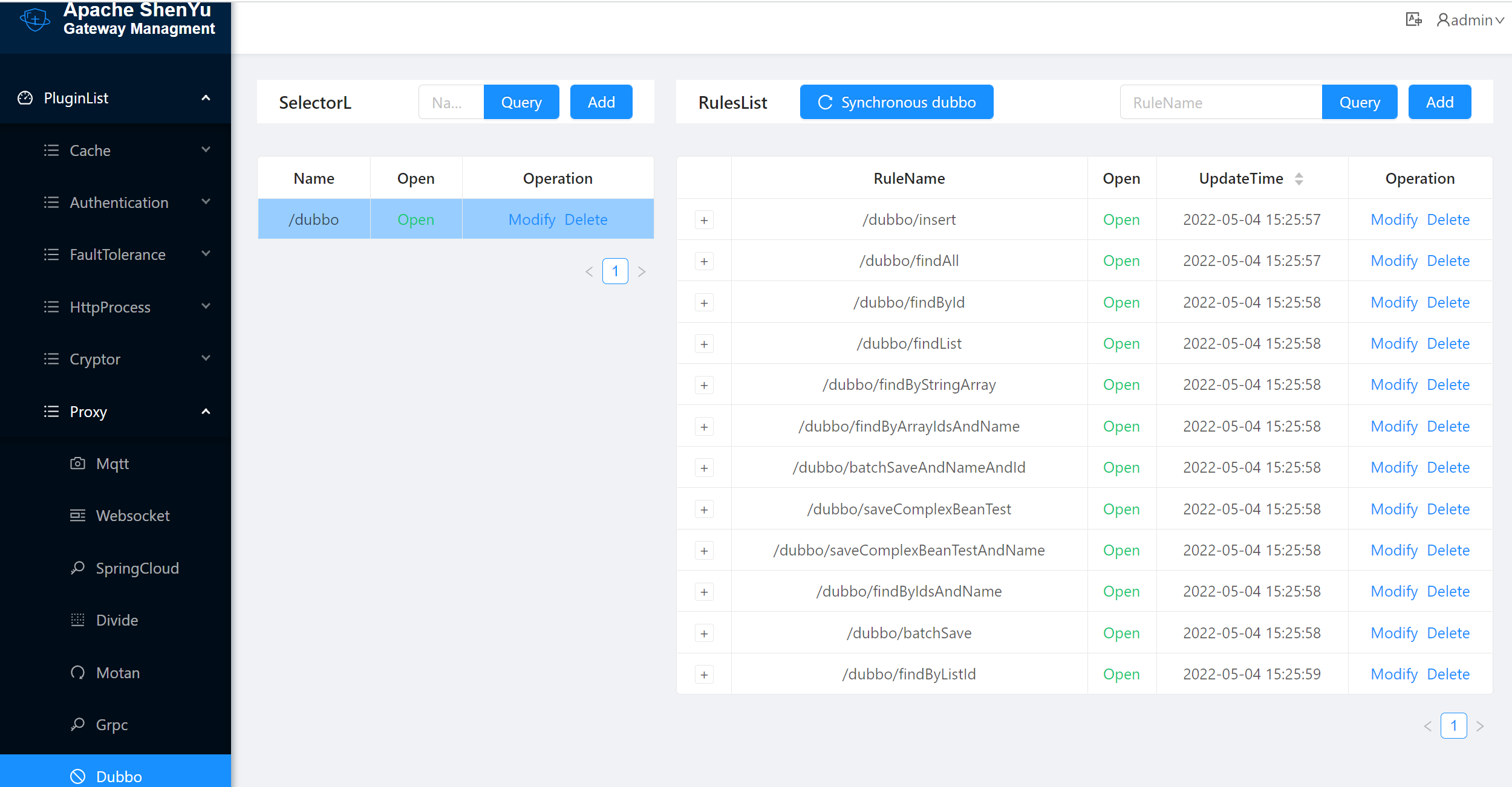
Successfully registered selector information:
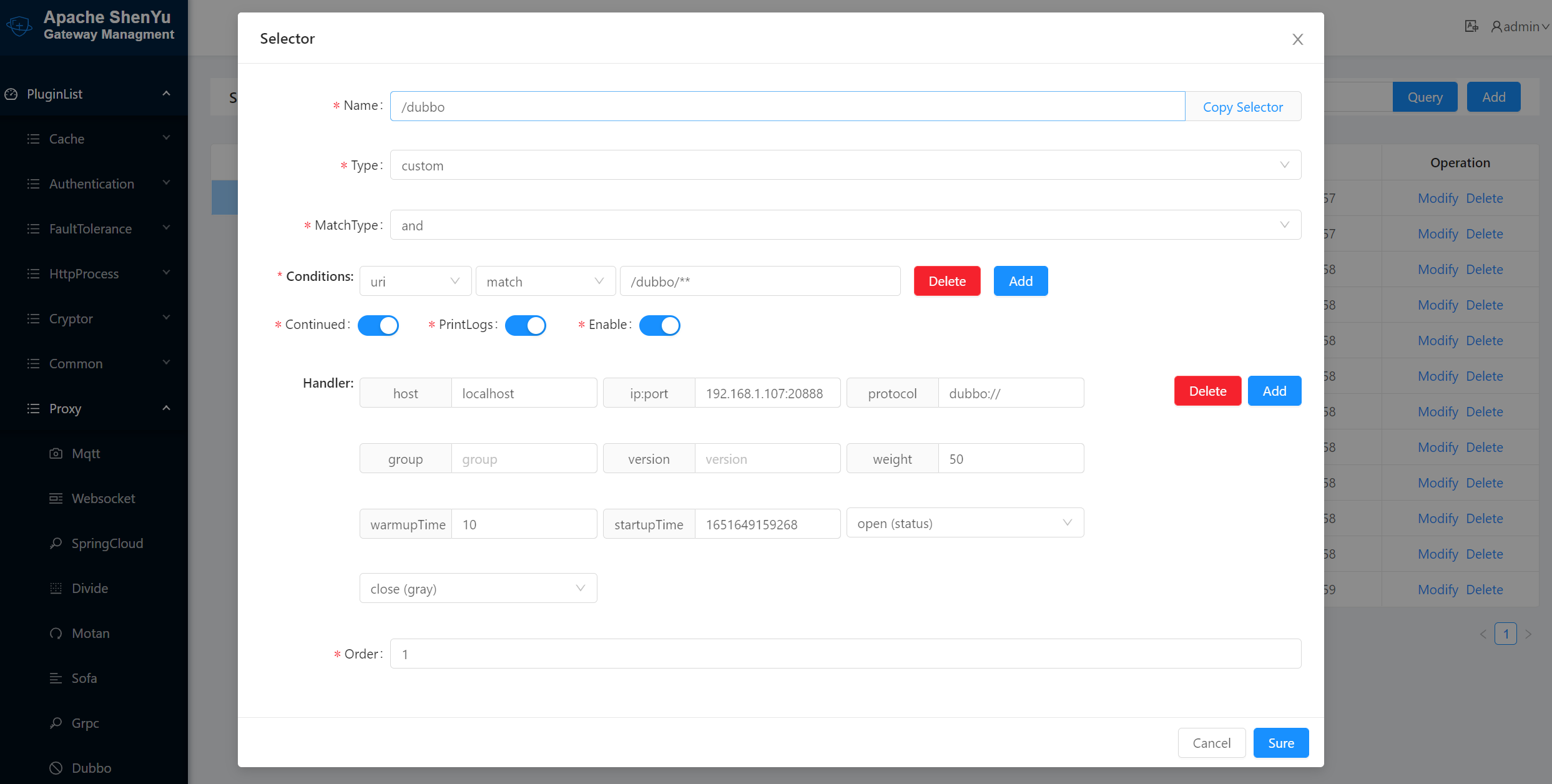
Successfully registered rule information:
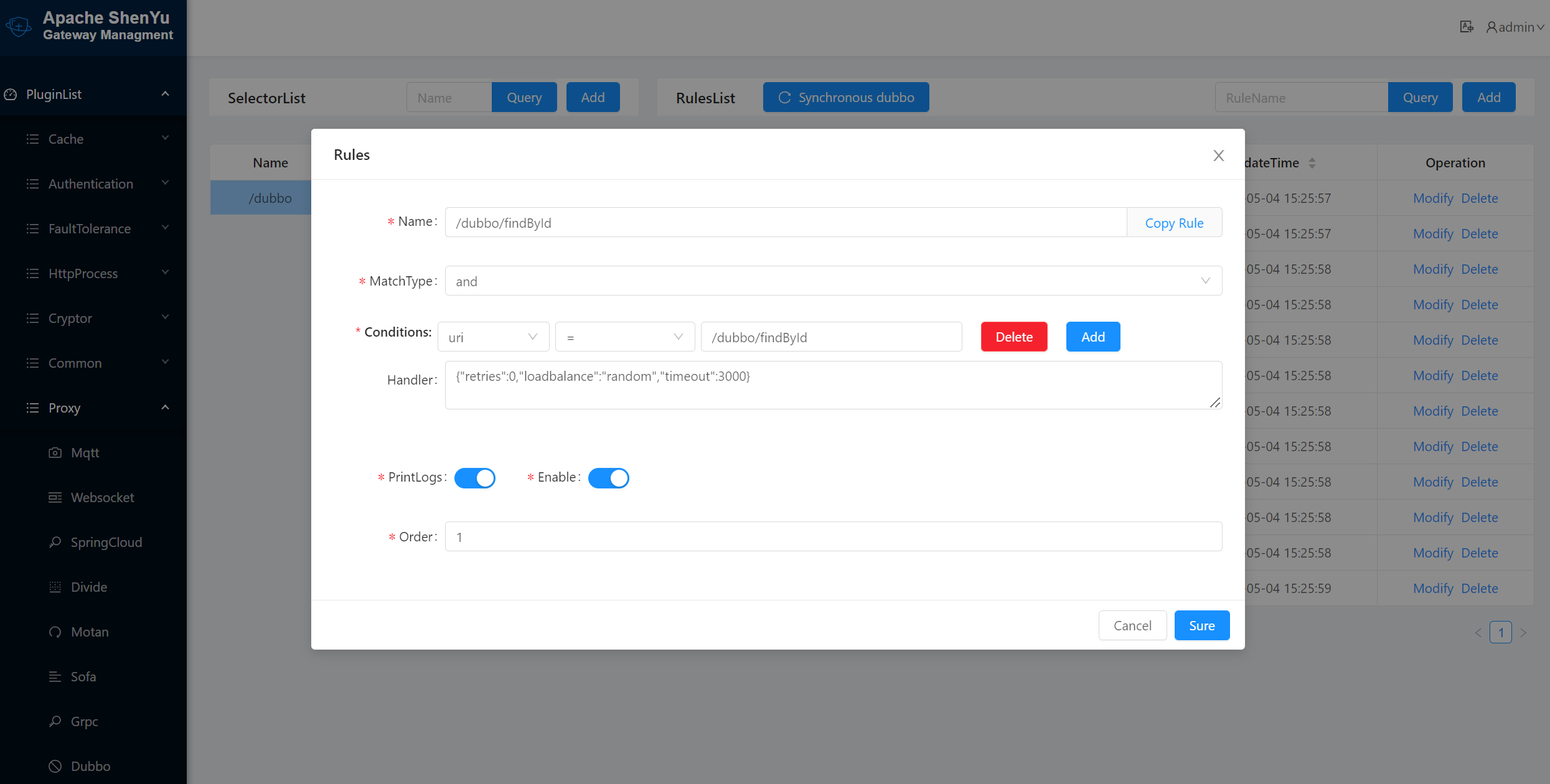
Selectors and rules are the essence of the
Apache ShenYugateway. Mastering them allows you to manage any traffic. The corresponding selector and rule matching conditions (conditions) can handle various complex scenarios based on different traffic filtering rules. Traffic filtering can retrieve data fromHeader,URI,Query,Cookie, etc. in the HTTP request.You can then use matching methods such as
Match,=,Regex,Groovy, andExcludeto match your expected data. Multiple matching conditions can be added withAnd/Orstrategies.For specific introductions and usage, please see:
[Selector and Rule Management](https://shenyu.apache.org/docs/user-guide/admin-usage/selector-and-rule).
Initiate a GET request to call dubbo service through ShenYu gateway:
GET http://localhost:9195/dubbo/findById?id=100
Accept: application/json
After a successful response, the result is as follows:
{
"name": "hello world shenyu Apache, findById",
"id": "100"
}
Thus, the dubbo service has been accessed successfully through the http request, and the ShenYu gateway has converted the http protocol into the dubbo protocol through the shenyu-plugin-dubbo module.
3. In-Depth Understanding of Dubbo Plugin
During the running of the above demo, you may have some questions:
- How is the
dubboservice registered toshenyu-admin? - How does
shenyu-adminsynchronize data to theShenYugateway? - How does
DubboPluginconvert thehttpprotocol to the dubbo protocol?
With these questions, let’s dive into understanding the dubbo plugin.
3.1 Application Client Access
Application client access refers to integrating microservices into the Apache ShenYu gateway, currently supporting protocols like Http, Dubbo, Spring Cloud, gRPC, Motan, Sofa, and Tars.
Integrating the application client into the Apache ShenYu gateway is achieved through a registration center, involving client registration and server data synchronization. The registration center supports Http, Zookeeper, Etcd, Consul, and Nacos, with the default being Http for registration.
For related configuration on client access, please refer to [Client Access Configuration](https://shenyu.apache.org/docs/user-guide/register-center-access).
3.1.1 Client Registration
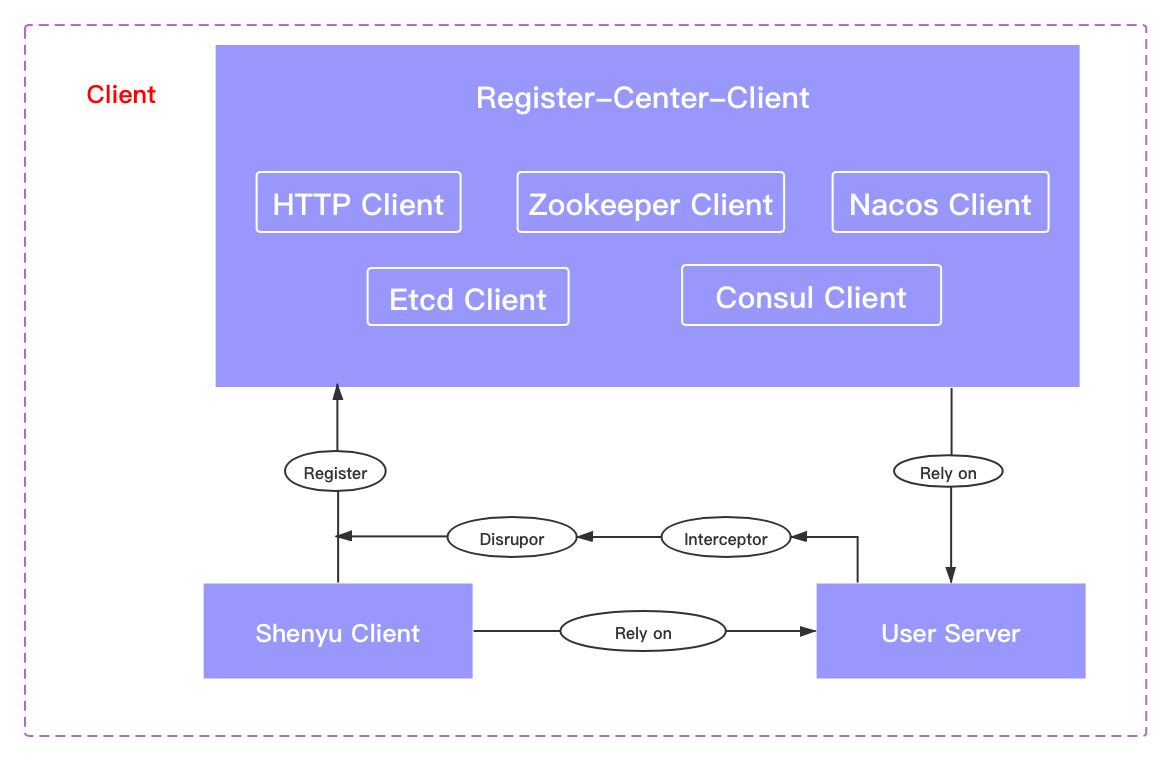
In your microservice configuration, declare the registration center client type, such as Http or Zookeeper.
When the application starts, it loads and initializes the corresponding registration center client using SPI, implementing the Spring Bean-related post-processor interface, fetching service interface information to register, and placing the information into Disruptor.
The registration center client reads data from Disruptor and registers the interface information to shenyu-admin, where Disruptor decouples data from operations, facilitating extension.
3.1.2 Server Registration
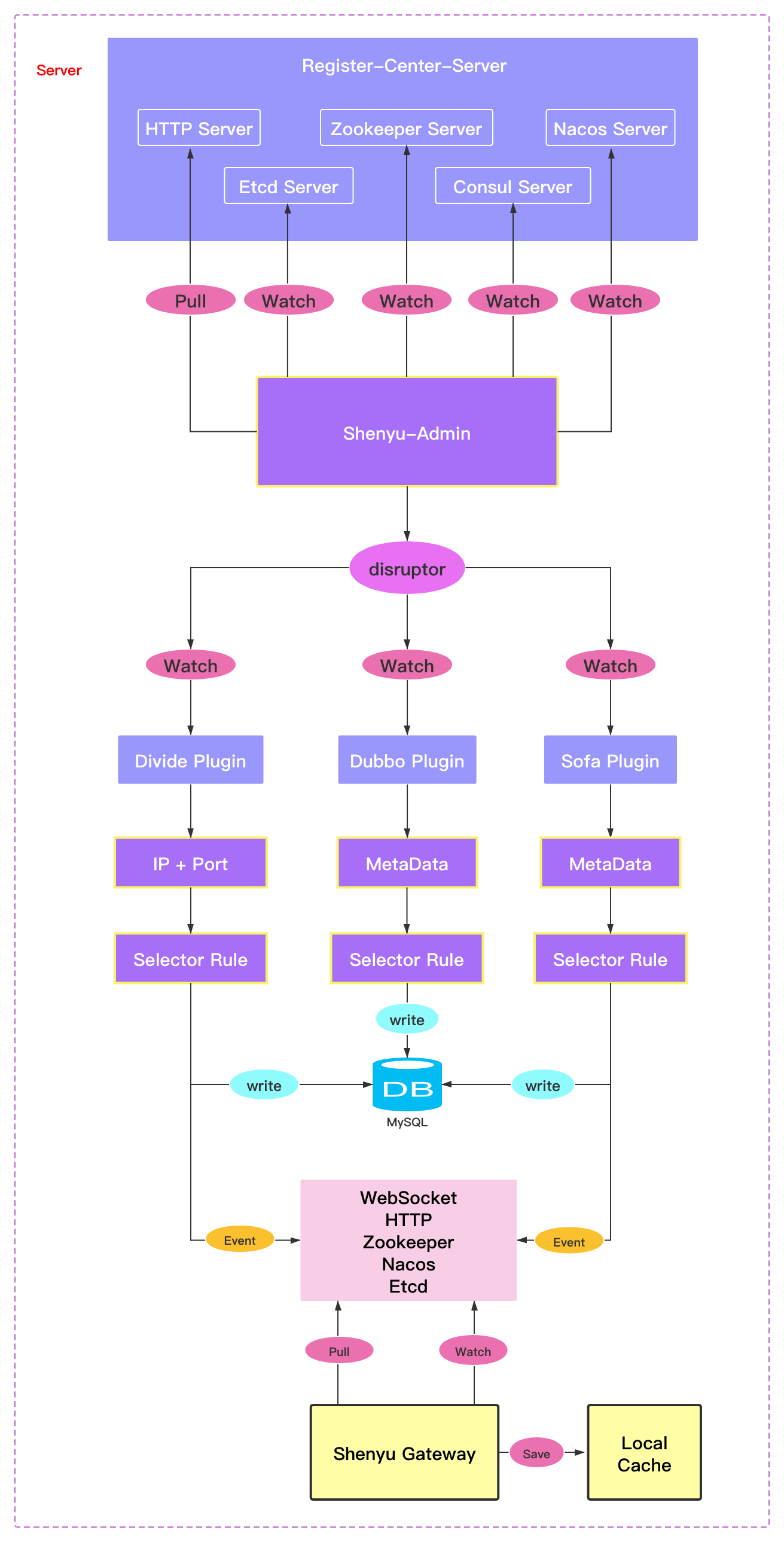
In shenyu-admin, declare the registration center server type, such as Http or Zookeeper. When shenyu-admin starts, it reads the configuration type, loads and initializes the corresponding registration center server. Once the registration center server receives interface information registered by shenyu-client, it places it in Disruptor, triggering registration logic to update and publish synchronization events.
Disruptor decouples data from operations for better extension. If there are too many registration requests causing registration exceptions, it provides data buffering.
3.2 Data Synchronization Principles
Data synchronization refers to how data is synchronized from the shenyu-admin backend to the Apache ShenYu gateway after operating the data. The Apache ShenYu gateway currently supports ZooKeeper, WebSocket, Http long polling, Nacos, Etcd, and Consul for data synchronization, with the default being through WebSocket.
For related configuration on data synchronization, please refer to [Data Synchronization Configuration](https://shenyu.apache.org/docs/user-guide/use-data-sync).
3.2.1 Significance of Data Synchronization
The gateway is the entry point for traffic requests, playing a crucial role in the microservice architecture. The importance of the gateway’s high availability is self-evident. During the use of the gateway, to meet business demands, configurations often need to change, such as flow control rules and routing rules. Therefore, dynamic configuration of the gateway is a significant factor in ensuring its high availability.
Current data synchronization features include:
- All configurations are cached in
Apache ShenYugateway memory, utilizing local caches for each request, providing very fast speeds. - Users can modify data in the
shenyu-adminbackend at will, and immediately synchronize it to the gateway memory. - Synchronization supports data synchronization for plugin, selector, rule data, metadata, signature data, etc., of
Apache ShenYu. - All plugins, selectors, and rules are dynamically configured and take effect immediately, without requiring service restarts.
- Data synchronization methods support
Zookeeper,Http long polling,Websocket,Nacos,Etcd, andConsul.
3.2.2 Analysis of Data Synchronization Principles
The diagram below illustrates the data synchronization process of Apache ShenYu. When the Apache ShenYu gateway starts, it synchronizes configuration data from the configuration service and supports push-pull modes to receive configuration change information, then updates the local cache. Administrators can modify user permissions, rules, plugins, traffic configurations in the management background (shenyu-admin), and synchronize this information to the Apache ShenYu gateway using either push or pull mode, depending on the synchronization method used.
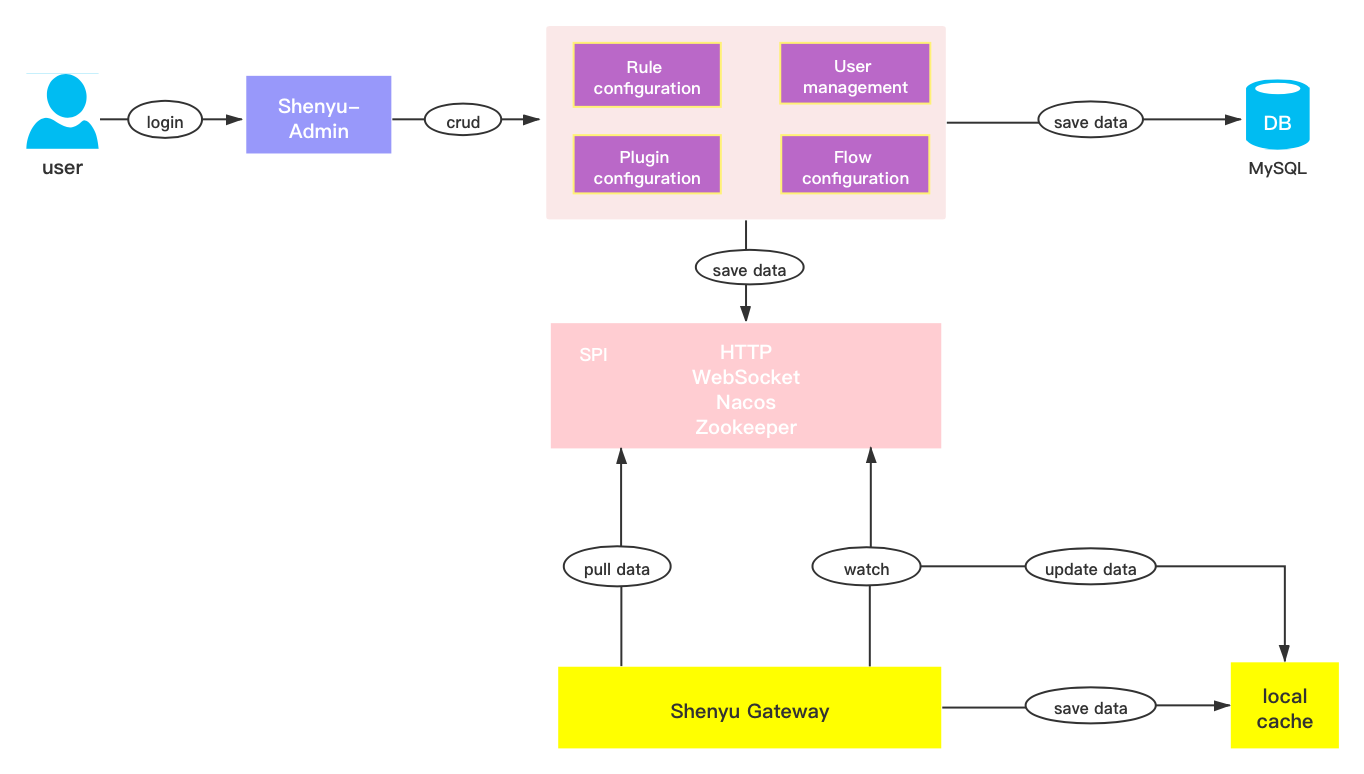
In earlier versions, the configuration service depended on Zookeeper for realization, pushing change notifications to the gateway from the management backend. Now it supports WebSocket, Http long polling, Zookeeper, Nacos, Etcd, and Consul, allowing configuration of shenyu.sync.${strategy} to specify the corresponding synchronization strategy, with the default using the webosocket synchronization strategy for sub-second data synchronization. However, it is crucial that the Apache ShenYu gateway and shenyu-admin use the same synchronization strategy.
As shown in the diagram below, after a configuration change occurs in the management backend (shenyu-admin), it issues a change notification through EventPublisher. The EventDispatcher processes this change notification, and according to the specified synchronization strategy (http, websocket, zookeeper, naocs, etcd, consul), sends the configuration to the corresponding event processor.
- If the synchronization strategy is
websocket, the altered data is actively pushed toshenyu-web, and there is a correspondingWebsocketDataHandlerin the gateway to handle the data push fromshenyu-admin. - If the synchronization strategy is
zookeeper, it updates the changed data tozookeeper, whileZookeeperSyncCachelistens to changes inzookeeperdata and processes it. - If the synchronization strategy is
http, the gateway actively initiates long polling requests with a default timeout of90s. If there are no data changes fromshenyu-admin, thehttprequest is blocked; if data changes occur, it responds with the changed data information. If there are no data changes after60s, it responds with empty data. Upon receiving the response, the gateway initiates anotherhttprequest, repeating the same request process.
3.3 Process Analysis
Process analysis shows service registration, data synchronization, and service calling processes from the source code perspective.
3.3.1 Service Registration Process
- Read dubbo service
Use the annotation @ShenyuDubboClient to mark the dubbo service that needs to be registered to the gateway.
Annotation scanning is accomplished through ApacheDubboServiceBeanListener, which implements the ApplicationListener<ContextRefreshedEvent> interface. During the Spring container startup, when a context refresh event occurs, it executes the event handling method onApplicationEvent(). In the overridden method logic, it reads the Dubbo service ServiceBean, builds metadata and URI objects, and registers with shenyu-admin.
For specific registration logic, please refer to [Client Access Principles](https://shenyu.apache.org/docs/design/register-center-design/).
- Handle registration information
The metadata and URI data registered by the client through the registration center are processed on the shenyu-admin end, responsible for storing in the database and synchronizing with the shenyu gateway. The client registration handling logic of the Dubbo plugin is in ShenyuClientRegisterDubboServiceImpl. The inheritance relationship is as follows:
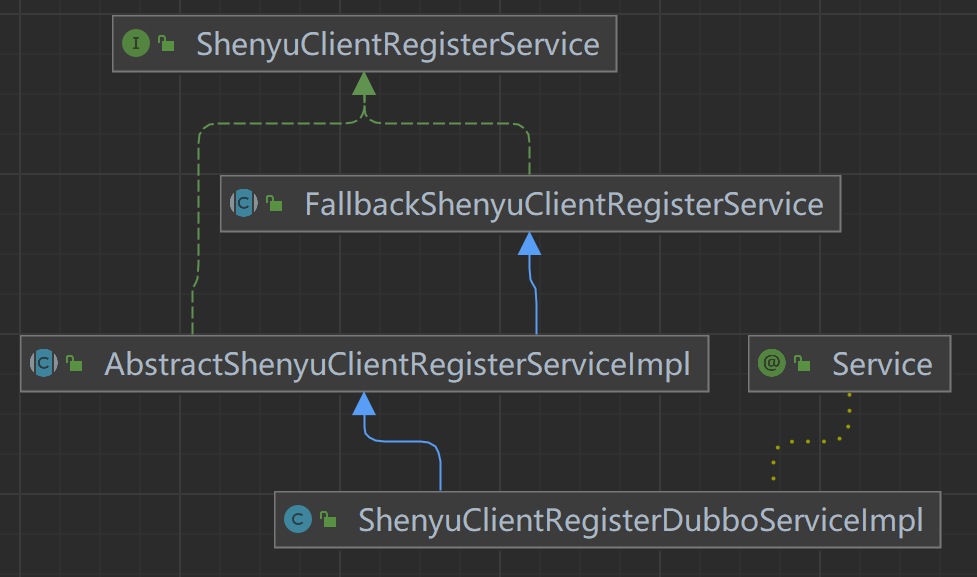
- ShenyuClientRegisterService: Client registration service, top-level interface;
- FallbackShenyuClientRegisterService: Registration failure, provides retry operation;
- AbstractShenyuClientRegisterServiceImpl: Abstract class implementing some common registration logic;
- ShenyuClientRegisterDubboServiceImpl: Implements the
Dubboplugin registration;
Registration information includes selectors, rules, and metadata.
The overall dubbo service registration process is as follows:
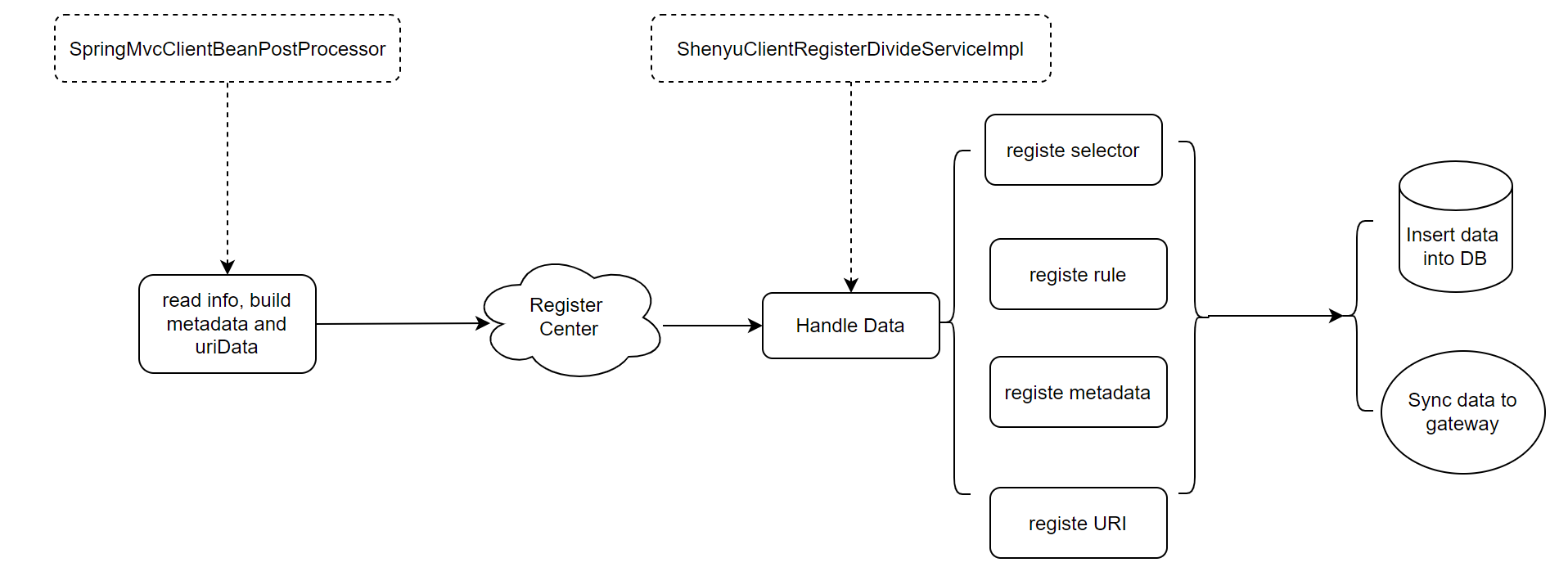
3.3.2 Data Synchronization Process
- Admin updates data
Suppose a new selector data is added in the backend management system; the request enters the SelectorController class’s createSelector() method, responsible for data validation, adding, or updating data, and returning result information.
In the SelectorServiceImpl class, the data is transformed and saved to the database, publishing the event and updating the upstream.
In the Service class, data persistence operations are completed, namely saving data to the database. The change data publication is done through eventPublisher.publishEvent(). The eventPublisher object is an instance of the ApplicationEventPublisher class, with the fully qualified name org.springframework.context.ApplicationEventPublisher, and the data publishing functionality is accomplished through Spring-related capabilities.
Once the event publication is complete, it automatically enters the DataChangedEventDispatcher class’s onApplicationEvent() method to handle events based on different data types and synchronization methods.
- Gateway Data Synchronization
Upon startup, the gateway loads different configuration classes based on the specified data synchronization method, initializing relevant data synchronization classes.
After data is received, deserialization operations take place to read the data type and operation type. Different data types have different data handling methods and corresponding implementation classes. However, shared logic can be implemented through a template method design pattern, placing common logic in the handle() method of the abstract class AbstractDataHandler, while differing logic is left to their respective implementation classes.
Adding a new selector data is an addition operation that enters the specific data processing logic within SelectorDataHandler.doUpdate().
The general plugin data subscriber, CommonPluginDataSubscriber, is responsible for handling all plugin, selector, and rule information.
The data is saved into the gateway’s memory; BaseDataCache is the final cache data class, achieved through the singleton pattern. Selector data is stored in the SELECTOR_MAP Map. In subsequent usage, data is also fetched from here.
The above logic is represented in the flowchart as follows:

3.3.3 Service Calling Process
In the Dubbo plugin system, the class inheritance relationship is as follows:
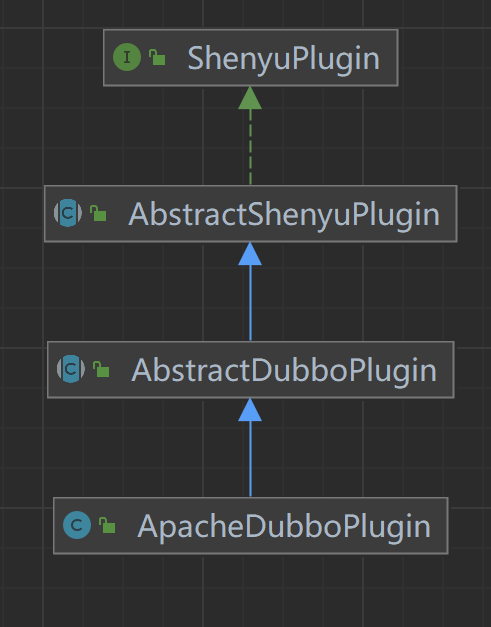
ShenyuPlugin: Top-level interface defining interface methods;
AbstractShenyuPlugin: Abstract class implementing shared plugin logic;
AbstractDubboPlugin: Abstract class for the dubbo plugin implementing shared
dubbologic (ShenYu gateway supports ApacheDubbo and AlibabaDubbo);ApacheDubboPlugin: ApacheDubbo plugin.
- org.apache.shenyu.web.handler.ShenyuWebHandler.DefaultShenyuPluginChain#execute()
Once proxied by the ShenYu gateway, the request entry is ShenyuWebHandler, which implements the org.springframework.web.server.WebHandler interface, connecting all plugins through the chain of responsibility design pattern.
- org.apache.shenyu.plugin.base.AbstractShenyuPlugin#execute()
When the request reaches the gateway, determining whether a plugin executes is achieved through specified matching logic. In the execute() method, selector and rule matching logic is executed.
- org.apache.shenyu.plugin.global.GlobalPlugin#execute()
The first to be executed is GlobalPlugin, a global plugin that builds context information in its execute() method.
- org.apache.shenyu.plugin.base.RpcParamTransformPlugin#execute()
Next is RpcParamTransformPlugin, which reads parameters from the http request, saves them to exchange, and passes them to the rpc service. In the execute() method, this plugin’s core logic executes: retrieving request information from exchange and processing parameters based on the request’s content format.
- org.apache.shenyu.plugin.dubbo.common.AbstractDubboPlugin
Then comes the execution of DubboPlugin. In the doExecute() method, it mainly checks metadata and parameters. In the doDubboInvoker() method, it sets special context information and then begins generic dubbo calls.
In the genericInvoker() method:
- Retrieve the
ReferenceConfigobject; - Get the generic service
GenericServiceobject; - Construct the request parameter
pairobject; - Initiate an asynchronous generic call.
By generic calling, the gateway can invoke dubbo services.
The ReferenceConfig object is the key object supporting generic calls, and its initialization occurs during data synchronization.
- org.apache.shenyu.plugin.response.ResponsePlugin#execute()
Finally, the ResponsePlugin is executed, handling the response result information from the gateway uniformly. The processing type is determined by MessageWriter, with the class inheritance relationship shown below:

MessageWriter: Interface defining message processing methods;
NettyClientMessageWriter: Handling results from
Nettycalls;RPCMessageWriter: Handling results from
RPCcalls;WebClientMessageWriter: Handling results from
WebClientcalls;
Response processing for Dubbo service calls is handled by RPCMessageWriter.
- org.apache.shenyu.plugin.response.strategy.RPCMessageWriter#writeWith()
In the writeWith() method, the response result is processed, retrieving the result or handling exceptions.
With this analysis, the source code analysis regarding the Dubbo plugin is complete, illustrated by the following flowchart:

4. Conclusion
This article starts from practical cases and gradually analyzes the proxying process of Dubbo services by the ShenYu gateway. The main knowledge points covered include:
- Executing plugins through the chain of responsibility design pattern;
- Implementing
AbstractShenyuPluginusing the template method design pattern to handle generic operation types; - Implementing the cache data class
BaseDataCacheusing the singleton design pattern; - Expanding functionality easily via
springboot starterto incorporate various registration centers and data synchronization methods; - Supporting hot updates of rules through
adminfor convenient traffic control; - Using the
Disruptorqueue to decouple data from operations and buffer data.